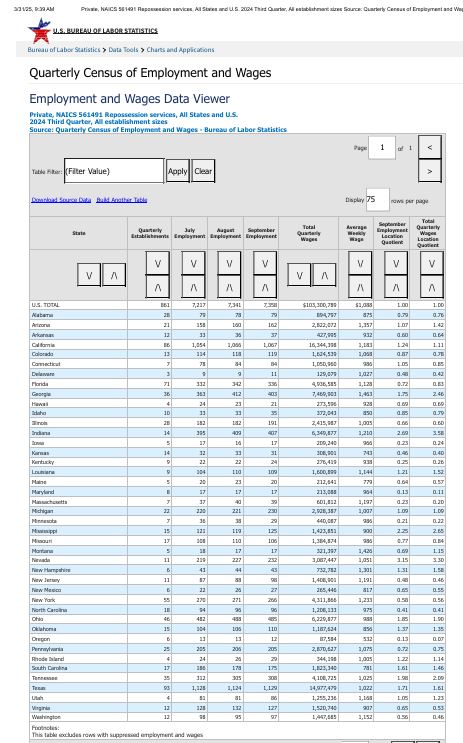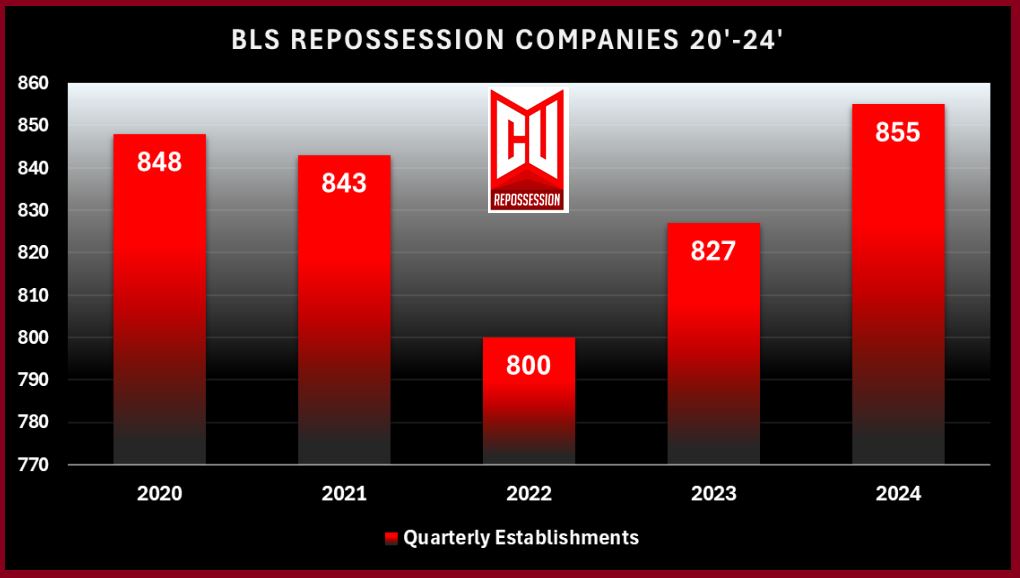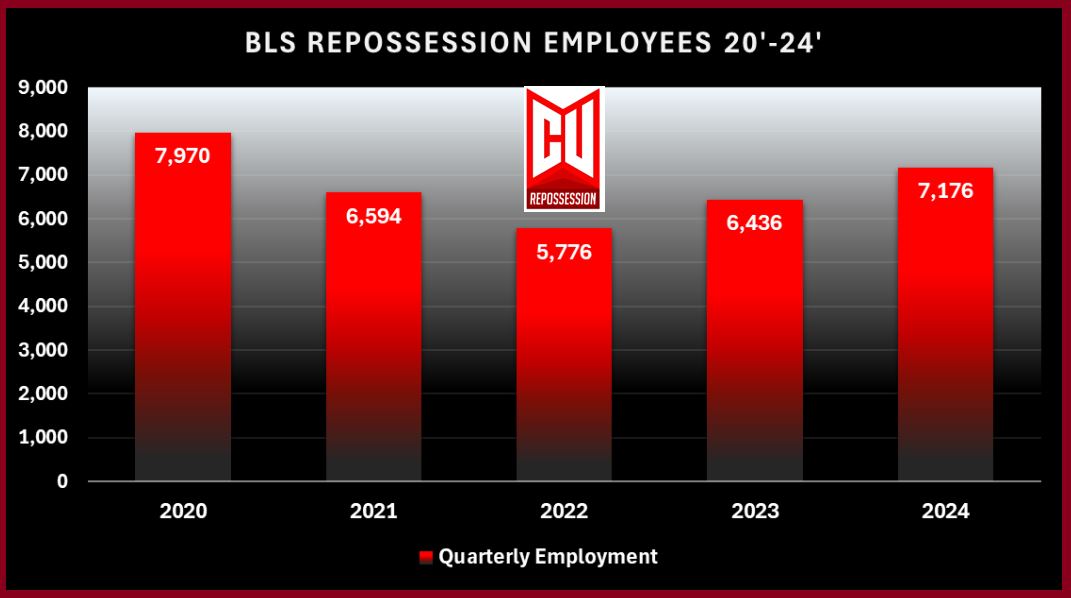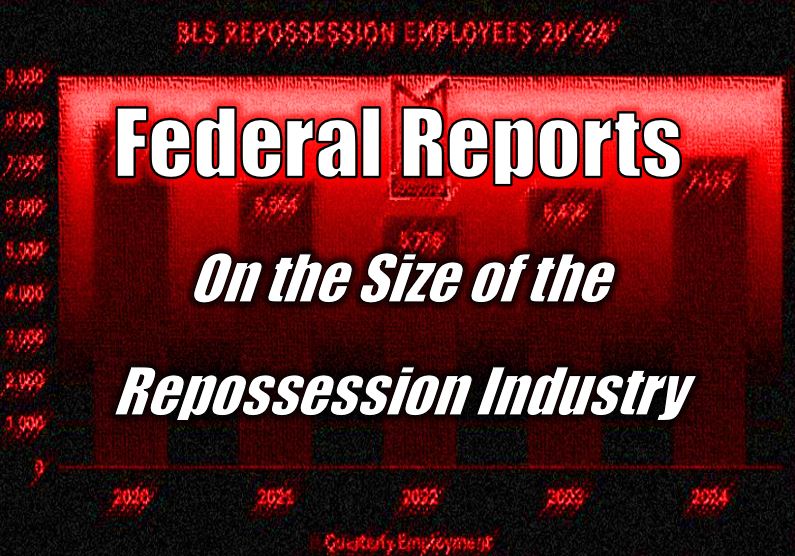That’s a loss of 48 agencies and 2,194 employees in those two years.
Having done exhaustive work to uncover the volume and scale of repossession activity in 2024, I went down the rabbit hole to find more. This time, I went searching for data on the size of the repossession industry. What I found was interesting but opens the door to many other questions.
Wild Estimates
As a little background, for years, people have tossed around estimates of the size of the repossession industry. From the repossession associations, I’ve heard that the numbers of operating repossession agencies tossed around always tend to sit between 2,500 to 3,000 through the years. But I’d never heard of their source or how many employees there were in the industry.
Back in June of 2019, Resolvion, one of the nation’s largest repo forwarding companies, stated in an article that the repo industry in the U.S. had more than 11,000 active firms in 2019, with just under 17,000 direct employment opportunities.
This was not Resolvion’s data. It was from a source called IBISWorld, a research firm. These seem extremely inflated. Regardless, it’s a good pre-pandemic set of data worth visiting.
Definitions

Now, for starters, what is the repossession industry? From a purist standpoint, it would be deemed as only persons employed by or owning a company that performs repossessions.
This, however, does not take into account all of the critical supporting companies that these agencies run on. Repo forwarding companies, LPR providers, SaaS, repo assignment software companies, insurance carriers; these are all major players in the modern repossession industry that have become valued and important partners in the industry’s development.
And while it is a disservice to the industry as a whole to omit these important companies, there are just too many hurdles to get our arms around any numbers in this vast ocean of providers. Once you see what I was able to uncover, you will better understand why this is so difficult.
So, for the sake of something resembling reliable data, we’re just going to focus on the “boots on the ground” agencies and agents. Luckily, there is a place to find this data. The Bureau of Labor Statistics (BLS).
BLS Repossession Classifications
The Bureau of Labor Statistics (BLS) tracks employment data for all industries. The repossession industry is captured under the category NAICS 561491 (Repossession Services). Understanding how they gather this data can shed light on the accuracy of the repo industry’s workforce numbers, but I’ll touch on that later.
Let’s cut to the chase.
The Official Numbers: What the BLS Tells Us
- The BLS data for Q3 2024 (July–September) shows a total of 7,358 employees in NAICS 561491 (Repossession Services) employed in 861 establishments (BLS). I believe it is safe to say that these are only headquarter offices and do not include satellite offices. So, the numbers may be much larger.

- That is up slightly from Q1 2024 when 7,176 employees worked for 855 agencies. This figure is in line with the data from years 2020 through 2023. Q4 2024 data is not yet available.
- Total reported quarterly wages were $103,300,789, with an average weekly wage of $1,088. That’s lower than the 2024 US average annual income reported by the BLS of $1,192. That’s sad, but I’m not going to get into that now.
BLS Data Available Here

Pandemic Recovery
- The data shows us that the industry shed 1,376 jobs and 5 agencies closed or were reclassified during the peak year of the pandemic in 2020.
- By Q1 of 2022, another 5% of agencies were gone along with another 14% of the workforce. That’s a loss of 48 agencies and 2,194 employees in those two years.
- By 2023, the industry began to rebound and another 27 agencies came back or were opened and another 660 employees were added. Fast forward to the beginning of 2024 and the industry has grown 7 agencies above the pre-pandemic period but is still operating with 794 less employees, but the average weekly wages have increased above pre-pandemic levels by 26%.

This is some interesting data. It provides some baseline historical data illustrating just what the repossession industry went through over the 5 years of reporting. As I am sure you have already noticed, these are some low-ball numbers.
If I haven’t lost you, below is an explanation on how they gather their data.
How the BLS Gathers Data
The BLS collects data through its Quarterly Census of Employment and Wages (QCEW) program, which is the backbone of their industry employment statistics. The QCEW program gathers data from state unemployment insurance (UI) programs, covering about 97% of nonfarm payroll jobs in the U.S. Here’s how it works:
- Data Collection from UI Records: Employers are required to report their employees and wages to state UI programs for tax purposes. These reports include the employer’s primary business activity, which states use to assign a NAICS code. For NAICS 561491, this means firms primarily engaged in repossessing assets ( cars, boats, or equipment) and should be classified here.
- Assigning NAICS Codes: States assign these codes based on employer-reported business descriptions, often collected during UI registration or through surveys. The BLS provides guidelines, but state agencies handle the initial classification, which can lead to inconsistencies.
- Surveys and Adjustments: The BLS supplements QCEW data with surveys which samples about 119,000 businesses monthly to estimate employment, hours, and earnings. For smaller industries like NAICS 561491, the QCEW is the primary source.
- Data Refinement: The BLS reviews and adjusts NAICS classifications over time. The BLS also conducts a process called “refiling,” where businesses are surveyed to confirm their NAICS code, ensuring accuracy. However, this process isn’t foolproof, especially for smaller industries.
This is all pretty dry. If this hasn’t made your eyes glaze over like a Krispy Crème donut, you’re more caffeinated than me.
As you can see, there are huge gaping holes in their data gathering process that are missing some very large portions of the industry. How many small owner operators are there out there that don’t report their business classification? How many companies are out there that classify as tow companies but do some portion of the work in repossessions?
Well, I do have some theories and some estimates, but that is a topic for another day.
Kevin Armstrong
Publisher
editor@cucollector.com
















Facebook Comments